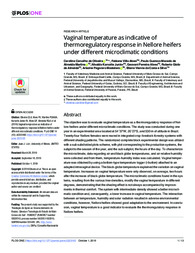Vaginal temperature as indicative of thermoregulatory response in Nellore heifers under different microclimatic conditions.
Vaginal temperature as indicative of thermoregulatory response in Nellore heifers under different microclimatic conditions.
Author(s): OLIVEIRA, C. C. de; ALVES, F. V.; MARTINS, P. G. M. de A.; KARVATTE JUNIOR, N.; ALVES, G. F.; ALMEIDA, R. G. de; MASTELARO, A. P.; SILVA, E. V. da C. e
Summary: The objective was to evaluate vaginal temperature as a thermoregulatory response of Nellore heifers under different microclimatic conditions. The study was conducted during one year in an experimental area located at 54?370W, 20?270S, and 530 m of altitude in Brazil. Twenty-four Nellore females were reared in integrated crop-livestock-forestry systems with different shading patterns. The randomized complete block experimental design was utilized with a sub subdivided plots scheme, with plot corresponding to the production systems, the subplot to the season of the year, and the sub subplot, the hours of the day. To characterize the microclimate, data regarding air and black globe temperatures, and air relative humidity were collected and from them, temperature-humidity index was calculated. Vaginal temperature was obtained by using a bottom-type temperature logger (i-button) attached to an adapted intravaginal device. The black-globe temperature explained the variation on vaginal temperature. Increases on vaginal temperature were only observed, on average, two hours after the increase of black-globe temperature. The microclimatic conditions found in the systems, resulting from the various tree densities, modify the vaginal temperature in different degrees, demonstrating that the shading effect is not always accompanied by improvements in thermal comfort. The system with intermediate density showed a better microclimatic condition and, consequently, a lower increase in vaginal temperature. The interaction between air temperature, humidity and solar radiation resulted in adverse environmental conditions, however, Nellore heifers showed good adaptation to the environment. In conclusion, vaginal temperature is a good indicator to evaluate the thermoregulatory response in Nellore heifers.
Publication year: 2019
Types of publication: Journal article
Unit: Embrapa Beef Cattle
Keywords: Gado Nelore, Novilho Leiteiro, Temperatura vaginal
Observation
Some of Embrapa's publications are published as ePub files. To read them, use or download one of the following free software options to your computer or mobile device. Android: Google Play Books; IOS: iBooks; Windows and Linux: Calibre.
Access other publications
Access the Agricultural Research Database (BDPA) to consult Embrapa's full library collection and records.
Visit Embrapa Bookstore to purchase books and other publications sold by Embrapa.

